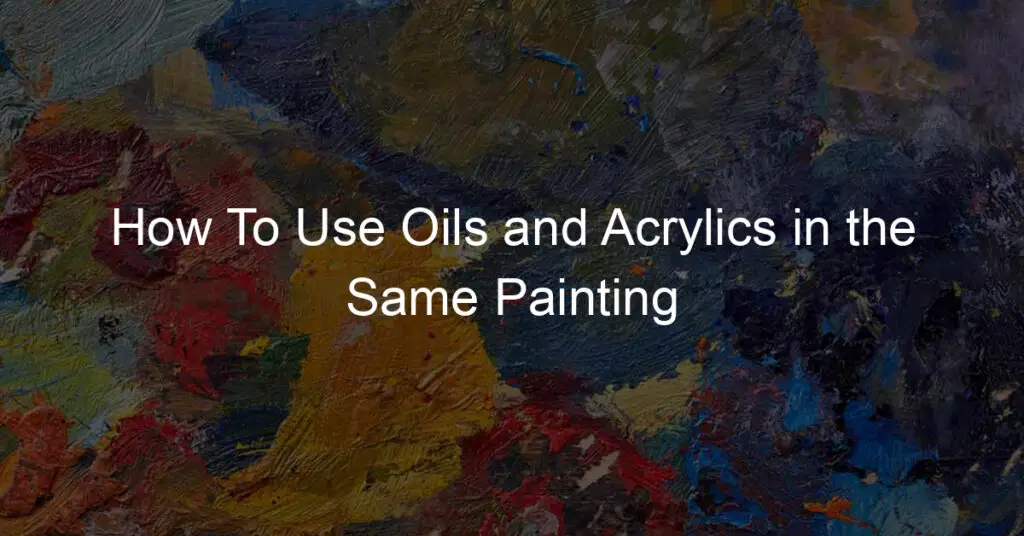Do you love the vibrancy of oil paints but also the versatility of acrylics? Or maybe you’re not sure which medium to use for your next painting project.
Well, good news! You can use both oils and acrylics in the same painting. By combining these two mediums, you can create some truly stunning effects.
Using acrylic and oil paint together
Painting with acrylic and oil together opens up various creative possibilities.
Acrylics tend to be brighter, dry faster, and can be easily thinned out with water if needed, while oils provide more luxurious textures and blend well between colors.
You can even mix the two mediums to create multi-dimensional art that takes advantage of the unique aspects of each.
By experimenting with acrylics and oils in tandem, the artist can craft masterpieces with unparalleled vibrancy. It’s a great way to add life and character to your work.
Why use oil over acrylic?
When it comes to choosing the right medium for a painting or drawing, oils, and acrylics are generally considered equally popular.
However, oil paints have been around far longer than their acrylic counterparts and consequently have a great deal of nostalgia associated with them.
Furthermore, they’re popular because they allow the artist to work on-site with greater speed and accuracy than most other mediums.
They also provide more richness in texture and color that can help bring a piece of art to life.
Additionally, oil paints are easier to manipulate, repair and touch up than acrylics. Ultimately, all these reasons combined make oil paintings attractive for those seeking an authentic artistic experience.
Oil over acrylic painting techniques
Painting techniques that use oil paints offer a unique style and look to your artwork.
Not only does oil provide you with more flexibility in terms of blending, shading, and layering colors, allowing for more detailed work, but it also offers more time to work with the paint before it dries.
Unlike acrylic paints which dry quickly, you can take up to several days or longer to work on an oil painting before having to clean it off your palette.
Additionally, there is less risk of cracking or bubbling because the oil paints dry slowly over some time.
With all these advantages provided by an oil painting technique, you’ve got something special at hand if you choose to go this route!
How to tell the difference between oil and acrylic paintings?
Oil and acrylic painting may look fairly similar, but there are plenty of ways to spot the difference between the two.
Oil paints appear richer and glossy because of their glossy finish. Acrylics give a more matte look, providing a canvas for more intense colors and less texture.
Generally speaking, oil paints will take longer to dry than acrylics since they use natural oils as the binder ingredient, unlike their acrylic counterpart which uses synthetic resins.
It’s also important to note that when it comes to longevity, oil paintings generally last longer than acrylic because they tend to take less damage from UV rays or extreme temperatures.
All in all, understanding how oil and acrylic paintings differ can give you some insight into an artist’s style and make it easier for you to decide whether a painting is right for you or not.
Can acrylic paintings look like oil paintings?
If you’re trying to decide what type of painting is right for you, acrylic and oil might be two of the options on the table.
But with so many qualities that separate each from the other, how do you know which will create the best outcome?
Fortunately, despite their differences, acrylics can provide a look that mimics oil paintings – allowing artists to enjoy both quality and convenience in one go!
Acrylics are great for amateurs due to their quick drying feature, and can also be used as a medium by more experienced painters who prefer its vibrancy or color clarity.
In both cases, if done with skill and attention to detail, acrylic works can match the complexity and depth of true oils – perfect for those who don’t have time (or patience) to spare.
Are oil paintings more valuable than acrylic?
Oil paintings have been venerated for centuries as a form of appreciation for compositional aesthetics, portraying everyday people and moments that inspire the artist.
They often take days or even weeks to complete, involving layers upon layers of oil paints, which makes them challenging yet rewarding works of art.
Because of the commitment and effort required to produce a high-quality painting with oils, many believe them to carry more value than acrylics, which are sometimes viewed as inferior.
Impassioned art collectors may be willing to pay more for a painting whose beauty can truly stand the test of time when compared to modern techniques such as acrylics.
Ultimately, it depends on an individual’s tastes and what kind of message they choose to have in their home.
Final Thoughts
In the end, it’s really up to you whether or not you want to use oils and acrylics in the same painting.
There are some benefits and drawbacks to both methods that you should consider before making a decision.
Ultimately, though, it’s essential to experiment with different techniques and see what works best for you. We hope this article has given you some food for thought on the matter!


















